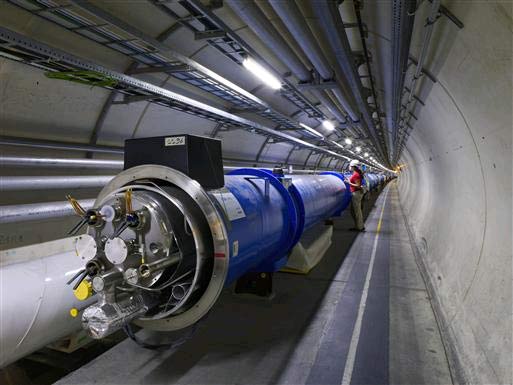Search for Magical Dark Matter Gets Real

UPTON, N.Y. — Though scientists don't yet know what dark matter is, it's probably in the room with you right now. Researchers hope to finally track down the stuff thought to make up most of the matter in the universe with the world's biggest atom smasher, which went online yesterday in Switzerland.
The secrets of dark matter, the mysteries of the so-called God particle, and extra dimensions in the universe are just a few of the exotic discoveries scientists are hoping to make with the Large Hadron Collider (LHC), a 17-mile (27-kilometer) circular tunnel running 300 feet (91 meters) underground near Geneva.
The $8 billion machine at the European Center for Nuclear Research (CERN) completed its first successful test run Wednesday, though in the coming days and months the real magic will begin, scientists say.
That’s when two beams of protons will race at close to the speed of light in opposite directions around the ring of LHC and collide to produce heaps of energy and, hopefully, some new particles no one has ever seen before.
“If things go well it could be days until we get our first collisions,” Steve Peggs, a researcher from Long Island’s Brookhaven National Laboratory who was at LHC for its opening test, said Wednesday via satellite from CERN. “But this is not like flipping the switch on a light bulb. Once the collisions start, we want to make them as bright as possible. It will probably take a number of years to get up to full performance.”
Scientists can’t say for sure when the first discoveries will come, but the machine is almost guaranteed to tell us something fundamental about the nature of the universe. If LHC doesn’t find the particles it’s looking for, it will mean physicists’ predictions have been way off and they must go back to the drawing board.
Great and small
Sign up for the Live Science daily newsletter now
Get the world’s most fascinating discoveries delivered straight to your inbox.
Though scientists are looking for some of the smallest things in the universe, they must use the biggest particle accelerator ever built to find them. The LHC’s vast size allows it to ramp up protons to extreme speeds that cause collisions powerful enough to recreate conditions in the universe only a trillionth of a second after the Big Bang.
This power is what scientists hope will provide the key to understanding the bizarre substance called dark matter, which astronomers know is there because of the gravity it creates; as one example, it holds galaxies together. But they don't know what it is and they can't see it. This stuff is thought to make up between 85 and 90 percent of all the matter in the universe, yet no one really knows what it is.
Physicists are hoping to catch the particle responsible for dark matter in action as a byproduct of a collision in LHC. One of the leading candidates for the dark matter particle is something called a WIMP, or Weakly-interacting Massive Particle. Some theories of WIMPs predict that they fall into the energy range of particles that could be produced in LHC.
Another mystery the machine could solve is how stuff acquires mass and why some particles have more mass than others. One possible answer, predicted by theory but never yet detected, is a particle called the Higgs boson (dubbed the God particle because it is widespread and powerful, yet difficult to prove).
“The LHC is a tremendous experimental venture because we really don’t know precisely what we’re going to find,” said Howard Gordon, a Brookhaven physicist who also works at LHC. “We don’t know if the Higgs will be there or not. Of course, the unexpected results are the things that might be the most interesting.”
Extra dimensions?
Some predictions of string theory can also be tested in the collider. String theory posits that all particles are made of tiny vibrating bands, and requires the universe to contain more dimensions than the simple three (plus time) that we currently perceive.
If those extra dimensions do exist, they could leave a signature in the collisions to take place at LHC. When protons smash in its tunnels, sophisticated detectors measure the energy and particles that spew off from the crashes. If some of this energy is escaping into the extra dimensions, LHC should be able to note the missing energy.
The detectors serve as researchers’ eyes and ears inside the experiment. Humans can’t be present in the tunnels while they are running because of the danger from radiation. Even if a person could peer inside, though, they wouldn’t see a thing — all the action is happening at the subatomic scale.
The opening of an accelerator with the potential to change our understanding of the universe marks a new era in physics, scientists say.
“As some might say, ‘One short trip for a proton, but one giant leap for mankind’”, said Nigel S. Lockyer, director of Canada’s particle physics laboratory TRIUMF.
- Will the Large Hadron Collider Destroy Earth?
- Video: See the CMS Construction
- Atom Smasher Works, World Survives










